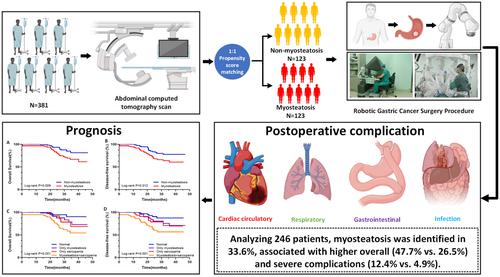Robotic gastrectomy is increasingly utilized for gastric cancer, but high morbidity remains a concern. Myosteatosis or low skeletal muscle density reflecting fatty infiltration, associates with complications after other cancer surgeries but has not been evaluated for robotic gastrectomy.
This retrospective study analysed 381 patients undergoing robotic gastrectomy for gastric cancer from September 2019 to October 2022. Myosteatosis was quantified on preoperative computed tomography (CT) images at lumbar 3 (L3). Propensity score matching addressed potential confounding between myosteatosis and non-myosteatosis groups. Outcomes were postoperative complications, 30 days mortality, 30 days readmissions and survival.
Myosteatosis was present in 33.6% of patients. Myosteatosis associated with increased overall (47.7% vs. 26.5%, p < 0.001) and severe complications (12.4% vs. 4.9%, p < 0.001). After matching, myosteatosis remained associated with increased overall complications, major complications, intensive care unit (ICU) transfer and readmission (all p < 0.05). Myosteatosis independently predicted overall [odds ratio (OR) = 2.86, 95% confidence interval (CI): 1.57–5.20, p = 0.001] and severe complications (OR = 4.81, 95% CI: 1.51–15.27, p = 0.008). Myosteatosis also associated with reduced overall (85.0% vs. 93.2%, p = 0.015) and disease-free survival (80.3% vs. 88.4%, p=0.029). On multivariate analysis, myosteatosis independently predicted poorer survival [hazard ratio (HR) = 2.83, 95% CI: 1.32–6.08, p=0.012] and disease-free survival (HR = 1.83, 95% CI: 1.01–3.30, p=0.032).
Preoperative CT-defined myosteatosis independently predicts increased postoperative complications and reduced long-term survival after robotic gastrectomy for gastric cancer. Assessing myosteatosis on staging CT could optimize preoperative risk stratification.


